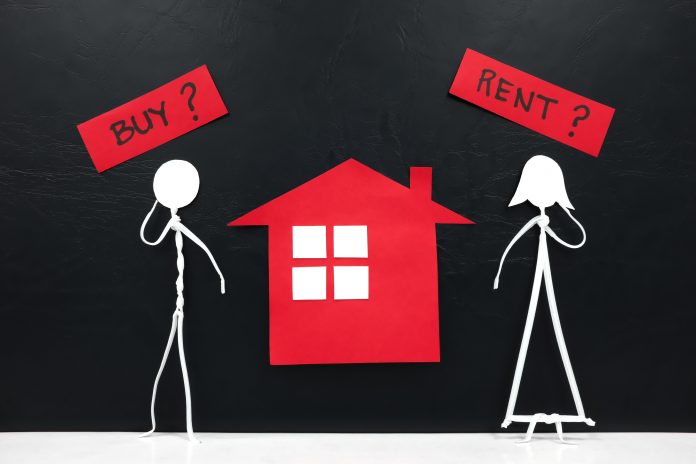Deciding between renting and buying a home in California can feel like picking the lesser of two evils—like choosing between braving Los Angeles traffic during lunch or finding parking in San Francisco during a holiday weekend. It’s a tough call with high stakes, where every option comes with its own set of challenges and rewards. With one of the most dynamic real estate markets in the country, this decision is packed with financial, lifestyle, and emotional considerations. Are you ready to settle into a beachfront rental in Malibu, or are you contemplating planting roots in the suburbs? Whatever your vision, we’re here to help you navigate the complexities, weigh the pros and cons, and laugh a little along the way. After all, if California’s taught us anything, it’s that life’s too short not to enjoy the ride.
The Financial Lowdown
Monthly Payments: Rent vs. Mortgage
When you rent, your monthly payment is straightforward: you hand it over to your landlord, and they handle the big stuff (mostly). With buying, the monthly mortgage payment includes principal, interest, property taxes, and homeowner’s insurance. Oh, and don’t forget HOA fees if you’re in a condo or planned community.
While renting is usually cheaper upfront, it doesn’t help you build equity. Buying, on the other hand, means that part of your payment works toward eventual ownership. Think of renting like paying for a hotel stay: convenient but not an investment. Buying is like purchasing the hotel—exciting but also stressful because now you’re the one responsible for repairs when the hot tub stops working.
Hidden Costs
Renters deal with security deposits and (sometimes surprise) rent hikes. Homeowners face down payments, closing costs, property taxes, and maintenance expenses. Let’s not forget the joys of unexpected surprises, like a leaky roof or a cranky water heater.
Pro Tip: Budget for the unexpected. Homeownership is a bit like camping—things will break, but it’s all part of the adventure. A good rule of thumb is to set aside 1% to 4% of your home’s value annually for maintenance and repairs. For example, if your home is worth $500,000, aim to save between $5,000 and $20,000 each year for those inevitable rainy-day expenses.
Building Wealth: Equity and Tax Perks
The Equity Advantage
Equity is the golden goose of homeownership. As you pay down your mortgage, you’re building ownership in your home, and with California’s real estate market, appreciation often adds to that value. Renters, on the other hand, pay for the privilege of living in someone else’s investment.
Think of equity as a financial safety net that grows over time. It’s the difference between what your home is worth and what you still owe on your mortgage. Every payment chips away at the loan principal, increasing your stake in the property. On top of that, rising home values—a common occurrence in many parts of California—can further boost your equity. This means that over time, your home isn’t just a place to live; it becomes a significant financial asset.
For renters, however, there’s no such opportunity. Monthly payments go toward someone else’s equity. While renting offers flexibility, it lacks the long-term financial growth associated with homeownership.
Tax Benefits Owning a Home vs Renting a Home
Homeownership comes with potential tax advantages that can soften the financial blow of property taxes and mortgage interest. If you itemize your deductions, you might be able to deduct these expenses from your taxable income, resulting in a lower overall tax bill. For Californians, where property taxes can be significant, this is no small perk.
That said, not everyone will benefit equally. With the rise in standard deductions in recent years, fewer homeowners find it advantageous to itemize. It’s essential to evaluate your unique financial situation or consult a tax professional to determine whether these deductions will meaningfully impact your bottom line.
Owning a home may offer financial perks, but the decision to buy should go beyond tax benefits. Consider how these savings align with your long-term financial and lifestyle goals.
Lifestyle Flexibility
Renting: Adaptable and Low Commitment
Renting is ideal if you’re not ready to commit to one place. It’s also great for those prone to wanderlust or job relocations. Plus, you’re off the hook for maintenance and repairs—just call the landlord and hope they answer.
This flexibility can be a lifesaver, as I discovered firsthand. Back in 2011, shortly after selling one of my companies, my then-wife and I decided to explore moving to Florida. We opted to rent a home with the shortest lease we could find, thinking we’d buy if we fell in love with the Sunshine State. Three months later, we were packing up and heading back to California! Renting gave us the freedom to test the waters without the long-term commitment of homeownership, saving us from what could have been a costly mistake.
Owning: Stability and Freedom
Homeownership offers stability and the freedom to customize your space. Want to paint your walls neon green? Go for it. Feel like installing a hot tub in the backyard? You’re the boss. Owning a home means having a space that’s truly yours, free from the limitations of rental agreements.
However, this stability comes with the expectation of staying put for a while. Selling a home isn’t as simple as breaking a lease, so it’s important to consider your long-term plans before taking the plunge.
Maintenance and Repairs
Renters enjoy the convenience of passing the buck when things go wrong. A leaky faucet? Call the landlord. The fridge stops working? Not your problem. But with homeownership, you’re not just the resident—you’re also the property manager, maintenance crew, and sometimes, the on-call plumber.
For homeowners, maintenance comes in all shapes and sizes. Routine tasks like mowing the lawn or replacing air filters are easy enough, but big-ticket repairs—think roof replacements or a failed HVAC system—can hit hard. That’s where your rainy-day fund comes in handy (and why budgeting 1%-4% of your home’s value annually is so crucial).

While renters might lose sleep over the landlord’s slow response time, homeowners find themselves wide awake at 2 AM watching YouTube tutorials on how to unclog a toilet or fix a hissing pipe. It’s a trade-off: renters give up control, but homeowners gain the privilege (and pain) of calling the shots.
Another thing to consider is customization. While renters can only dream about knocking down walls to create their ideal space, homeowners have the freedom to renovate—but every renovation is a double-edged sword. That new kitchen backsplash? Yours to enjoy and yours to fix when it chips. Owning a home is rewarding, but it’s not for the faint of heart (or wallet).
The Market Factor
California’s real estate market is notorious for its high prices and fierce competition. Homes in sought-after areas like the Bay Area or Los Angeles can often spark bidding wars, pushing prices well above asking. This makes buying a daunting task for first-timers, but it’s not all bad news. In less competitive areas or during market slowdowns, buyers may find opportunities for better deals.
On the flip side, renting in California isn’t a cakewalk either. Demand for rentals tends to skyrocket during housing shortages, leading to inflated prices and limited options. Tenants often face stiff competition, especially in prime locations. While renting may seem like the easier path, it’s not always the cheaper one, particularly in high-demand cities.
The 5% Rule
A useful tool for weighing the financial feasibility of buying is the 5% rule. This guideline suggests that if the annual cost of owning a home—including mortgage payments, property taxes, and maintenance—is less than 5% of the property’s purchase price, buying might be a sound investment. If these costs exceed 5%, renting could be the more economical choice.
For example, let’s say you’re eyeing a $600,000 home. Using the 5% rule, you’d budget $30,000 annually for ownership costs. If your calculations show that owning costs less than this threshold, it’s likely a better long-term financial move. However, if your estimated costs come in higher, renting may save you money and offer greater flexibility.
It’s important to remember that this rule isn’t one-size-fits-all. Factors like your income stability, future plans, and local market conditions play a significant role in the decision. Consulting a financial advisor can provide clarity and help tailor the decision to your unique circumstances.
By understanding these trends and applying practical guidelines like the 5% rule, you can make an informed choice that aligns with both your financial goals and lifestyle needs.
Pros and Cons at a Glance
6.1 Renting
Pros:
- Lower upfront costs.
- Flexibility to move.
- No maintenance responsibilities.
Cons:
- No equity.
- Potential for rent increases.
- Limited customization options.
6.2 Buying
Pros:
- Builds equity over time.
- Freedom to renovate.
- Tax benefits and stability.
Cons:
- High upfront costs.
- Maintenance and repair responsibilities.
- Less flexibility for relocations.
Tips for Deciding which makes more sense: Renting or Buying a Home?
Making the decision to rent or buy is never a one-size-fits-all process. However, by focusing on a few key areas, you can narrow down what’s best for you. Here are expanded tips to guide you:
- Financial Readiness: Start by assessing your income, savings, and credit score. Can you comfortably afford a down payment, closing costs, and the ongoing expenses of homeownership? If not, renting might be the smarter choice until you’ve built up your financial reserves.
- Long-Term Goals: Consider where you see yourself in five or ten years. Are you planning to settle down, start a family, or stay in one location for the foreseeable future? If yes, buying could align with your goals. If you anticipate career changes or relocations, renting offers the flexibility to adapt.
- Lifestyle Preferences: Ask yourself what kind of lifestyle suits you. Do you want the freedom to renovate and personalize your space? Or do you prefer the convenience of leaving maintenance to someone else? These preferences can help clarify your decision.
- Location Matters: California’s real estate prices vary widely, from the pricey Bay Area to more affordable inland regions. Research the market in your desired area to determine whether buying or renting makes sense financially. Look at property trends, rental vacancy rates, and the average time homes stay on the market.
- Plan for the Future: Even if you’re renting now, it’s never too early to start saving for a down payment. Set aside a portion of your income each month in a high-yield savings account or other investment vehicle. Building this financial cushion can position you to buy when the time is right.
- Weigh the 5% Rule: Use the 5% rule as a guideline to compare renting and buying costs. This tool helps you gauge whether owning a home aligns with your financial goals.
- Consult Professionals: Don’t shy away from seeking advice. Realtors, financial advisors, and mortgage brokers can provide valuable insights tailored to your situation. They can help demystify the process and ensure you make a well-informed choice.
Remember, the right decision isn’t just about numbers. It’s about what feels right for your current situation and future aspirations. Take your time, do your research, and make a choice that aligns with your priorities and peace of mind.

Final Thoughts: Making the Call
Renting and buying both have their merits, and the right choice depends on your personal circumstances. Renting might be your best bet if you prioritize flexibility and lower upfront costs. On the other hand, buying offers stability and the opportunity to build equity over time.
Is Renting Always Cheaper?
Not necessarily. While renting may seem more affordable in the short term, it’s important to factor in potential rent increases and the lack of equity-building opportunities. For example, in competitive California markets, rising rental costs can sometimes rival or even exceed the costs of owning a home. Running the numbers for your specific situation—including location, lifestyle, and financial readiness—is key to determining the best financial move.
Is Buying a Home a Good Investment?
In many cases, buying a home can be a strong long-term investment, particularly in California, where property values tend to appreciate over time. However, it’s not without risks. Market fluctuations can affect property values, and the costs of ownership—including maintenance, property taxes, and mortgage interest—must be carefully considered. Evaluate your financial goals and timeline to decide if homeownership aligns with your broader investment strategy.
Whatever you decide, align your choice with your lifestyle and financial goals—and don’t forget to enjoy the journey, whether it’s decorating your first apartment or hosting a housewarming in your new home.
Renting and buying both have their merits, and the right choice depends on your personal circumstances. Renting might be your best bet if you prioritize flexibility and lower upfront costs. On the other hand, buying offers stability and the opportunity to build equity over time. Whatever you decide, align your choice with your lifestyle and financial goals—and don’t forget to enjoy the journey, whether it’s decorating your first apartment or hosting a housewarming in your new home.


